In recent weeks, the number of COVID-19 infections has been drastically increasing in multiple countries. Experts predict that the rate will continue to climb throughout and after the holiday season. People across the world are trying to live their lives as normally as possible while avoiding contagion as they await a vaccine. Unfortunately, going about business as usual is quite anomalous to staying healthy – but methods do exist to minimize the risk of illness.
Experts predict that the rate will continue to climb throughout and after the holiday season. People across the world are trying to live their lives as normally as possible while avoiding contagion as they await a vaccine. Unfortunately, going about business as usual is quite anomalous to staying healthy – but methods do exist to minimize the risk of illness.
One of the areas of greatest focus and concern are our educational facilities and protecting our youth. Some schools have gone to all-virtual learning, but many have stayed open in an effort to reduce strain on working parents while allowing children to learn in as normal an environment as possible. This, understandably, worries parents, who want to know exactly what schools are doing to keep their children safe.
Dassault Systemes’ SIMULIA’s airflow solutions leveraging highly accurate Computational Fluid Dynamics (CFD) simulation software are playing a large role in increasing safety for students during the pandemic. SIMULIA team members have used simulation to study three factors that can potentially curb the spread and keep students safer, in particular: mask-wearing, ventilation patterns, and seating arrangements.
Masks
COVID-19 has been shown to spread through secretions from the mouth and nose, which travel through the air in the form of droplets of all sizes (including the dreaded aerosols) from sneezing, coughing, and even talking. By this time, most people know that masks are a highly effective way of keeping these droplets from traveling from person to person, and simulation has demonstrated this to be the case. Some schools, however, do not require students to wear masks, and even in those that do, children are required to take their masks off to eat lunch. Kids being kids, they may not always put their masks back on quickly enough after eating, and may take them off or wear them incorrectly at other times – so there needs to be a next line of defense.
Ventilation
Ventilation is key. A good ventilation system can transport airborne droplets outside of the classroom before they can land on surfaces or be inhaled by students and teachers. It can also help minimize high droplet concentration areas, possibly associated to higher risks of contagion. Simulation has determined that in a typical classroom with natural ventilation, i.e. with windows open and a breeze blowing, 14 percent of droplets left the classroom within one minute. This percentage rose to 20 when added side exhaust fans were turned on, and to 22 when central exhaust fans were turned on. Forced ventilation, therefore, particularly an efficient central HVAC system, is a major factor in removing droplets from a room before they can infect anyone. Integration is key as mastering the airflow in the room can dramatically reduce the concentration in droplets, while a poorly integrated one may make the situation worse. We demonstrated this in our work with hospitals in France.
Seating Arrangements
Also of great importance is where students sit in relation to each other. A recent study made the following assumptions:
- Room temperature is 26 degrees Celsius
- Equal probability for every student to be a source of the pathogen
- Viral load is 900 particles per hour
- Mean diameter of particles is one micron
- Single contamination path is via aerosols (airborne small droplets)
Our simulations were performed on three classroom configurations: one with 40 students in the room, and two with 20 students. Using state-of-the-art engineering methods and numerous runs, the study discovered that an unexpected optimum layout consisted of 20 students, in the configuration shown below. The airflow distribution in the room led to an expected layout, compared to a traditional one maximizing the distance between students, something specific to the ventilation hence a room by room dependency.
Health Outside the Home
Using SIMULIA CFD solutions, it is possible to arrange for better protection in the classroom. A room with 20 students, arranged according to the simulation findings, with central exhaust fans turned on, is the safest environment for children in the midst of the pandemic – and it’s even safer if those students are wearing masks.
While there is no foolproof way to ensure 100 percent that an individual does not contract COVID-19 (other than literally never coming into contact with another human being), simulation is capable of accurately evaluating an environment to allow engineers to configure one that is as safe as possible until a vaccine arrives – not only in classrooms, but in workplaces and even hospitals as well. SIMULIA expert services teams are available to help companies with these types of simulations and can run them quickly on the SIMULIA Cloud, providing the greatest chances for good health outside the home.
Note: This post originally appeared in Dassault Systemes’ SIMULIA Blog.
